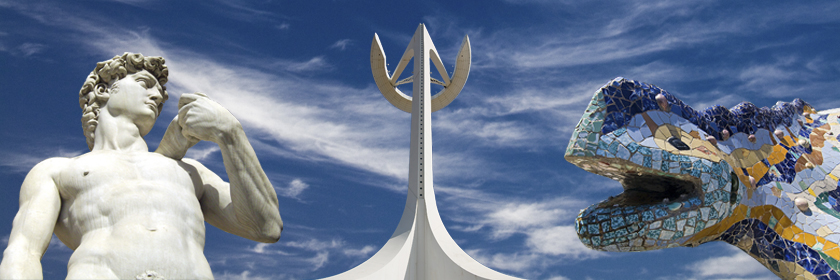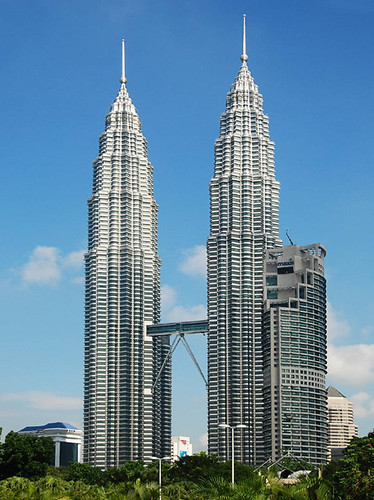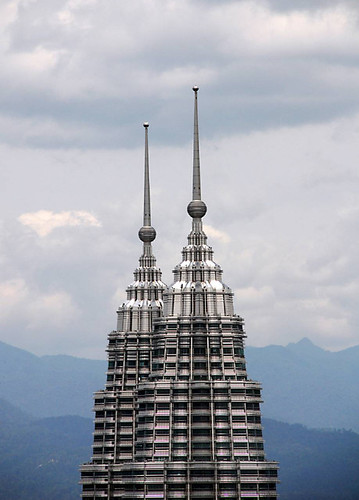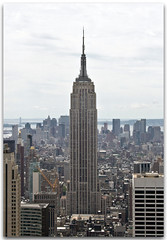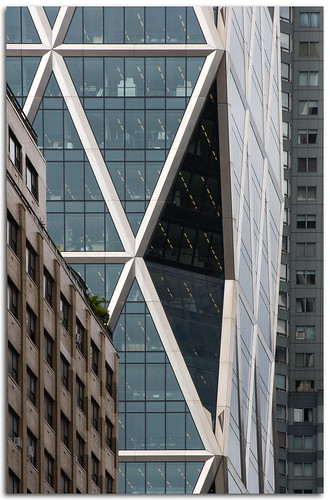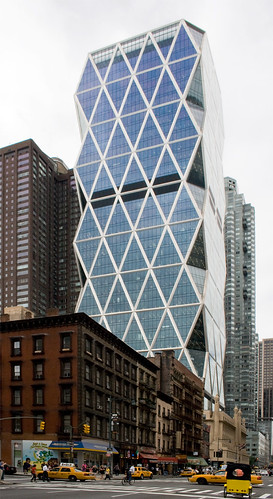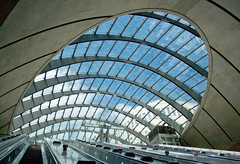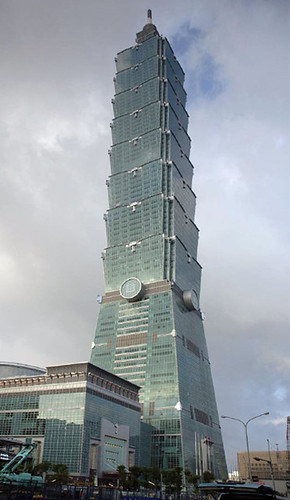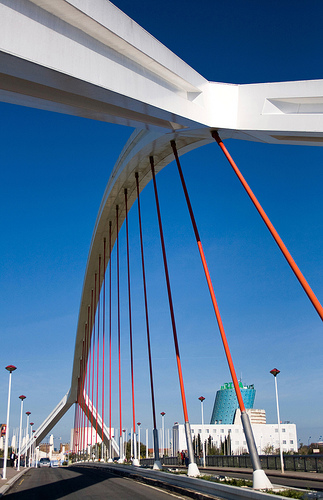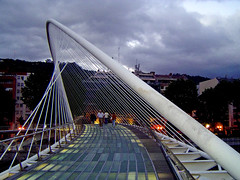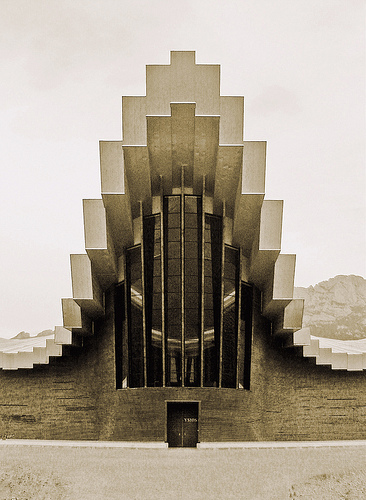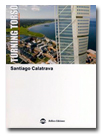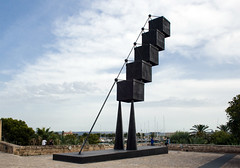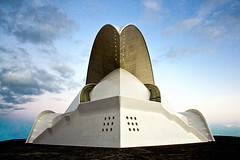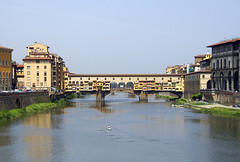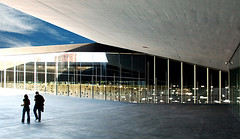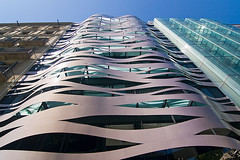CALATRAVA - SU OBRA EN ESPAÑA
CALATRAVA-SU OBRA EN ESPAÑA
by José Miguel Hernández Hernández
Editor, Escritor y Fotógrafo de Arquitectura
Publisher, Writer and Architectural Photograpger
www.jmhdezhdez.com Leer más...
Petronas Towers, Kuala Lumpur, Malaysia, 1992-1998

ESPAÑOL
Cliente: Autoridades Locales de Malasia
Arquitecto: César Pelli & Associates Architects
Ingeniero Estructural: Thornton-Tomasetti Engineers, US,
and Ranhill Bersekutu Sdn Bhd, Malaysia
Categoría: Rascacielos (Super-Tall) + 300 metros
Altura de las torres: 452 metros
Superficie: 341.760 m²
Plantas: 88
Uso: Mixto
El prestigioso arquitecto César Pelli se inspiraba en los motivos tradicionales del arte islámico para diseñar estas majestuosas torres localizadas en la ciudad de Kuala Lumpur, Malasia. La forma de cada planta está compuesta por la figura de dos cuadrados entrelazados con un círculo concéntrico, que unidos, forman el perímetro de cada torre. La Torre 1 es la Sede Petronas y en la Torre 2 se encuentra el Club de Malasia. Las enormes fachadas están revestidas por nada menos que 65000 m² de acero inoxidable y 67000 m² de vidrio. Desde el piso 29 arrancan cuatro apoyos inclinados de acero con forma de v invertida de 51 metros de longitud total, que soportan el peso del “Skybridge” (Puente del Cielo). Este puente, que se encuentra situado a 170 metros de altura, une la torre 1 y 2 desde los pisos 41 y 42, no sólo para facilitar el movimiento a los usuarios del edificio, sino para ofrecer un servicio de emergencia o posible incendio.
Los rascacielos están dotados de un sistema inteligente de ordenadores que hacen de las torres unas de las más seguras del mundo. Además, cada torre está equipada con 29 ascensores de dos plantas que suben a una velocidad de entre 3.5 y 6 metros por segundo. Los dos pináculos gemelos que coronan las agujas y que están hechos de acero estructural, tienen 73.5 metros de altura cada uno; cada pináculo pesa nada menos que 176 toneladas y hacen de estas bellas torres todo un símbolo de Malasia. La famosas Torres Petronas fueron las más altas del mundo entre 1998 y 2003, hasta que terminó la construcción de la Torre de Taipei en la isla de Taiwán, el 17 de octubre de 2003.
El texto de este artículo se incluye en mi libro titulado "CONSTRUCCIONES FAMOSAS" / The text of this item is included in my book title "FAMOUS CONSTRUCTIONS" Español - English
by José Miguel Hernández Hernández
Publisher, Writer and Architectural Photographer
www.jmhdezhdez.com
Video promotional
ENGLISH
Client: Local Authorities in Malaysia
Architect: César Pelli & Associates Architects
Structural Engineer: Thornton-Tomasetti Engineers, US,
and Ranhill Bersekutu Sdn Bhd, Malaysia
Categorie: Skyscraper (Super-Tall) + 300 metros
Height of towers: 452 meters
Surface: 341.760 m²
Plants: 88
Use: Mixed
The renowned architect César Pelli was inspired by traditional motifs of Islamic art to design these majestic towers located in the city of Kuala Lumpur, Malaysia. The shape of each plant is composed of the figure of two interlocking squares with a concentric circle, which together form the perimeter of each tower. Tower 1 is the Headquarters and Petronas Tower 2 is the Club of Malaysia. The massive walls are lined with no less than 65000 m² to 67,000 m² stainless steel and glass. From the 29th floor four supports inclined tear steel inverted V-shaped 51 meters in length, that bear the brunt of the "Skybridge" (Bridge of Heaven). This bridge, which is situated at 170 meters, connects the Tower 1 and 2 from the floors 41 and 42, not only to facilitate the movement of the building users, but to provide an emergency service or possible fire.
The skyscrapers are equipped with an intelligent system of computers that make the towers a few of the safest in the world. In addition, each tower is equipped with 29 elevators that go up two floors at a speed of between 3.5 and 6 meters per second. The two twin pinnacles that crown the needles are made of structural steel are 73.5 meters high each, with pinnacle weighs no less than 176 tons of these beautiful towers are a symbol of Malaysia. The famous Petronas Towers were the tallest in the world between 1998 and 2003, until he finished building the Tower of Taipei on the island of Taiwan, 17 October 2003.
Image 1 © Copyright Szelee Teo, Web: Szelee
Photostream, link: www.flickr.com/photos/teoszelee/
Image 2 © Copyright www.flickr.com/photos/vpzone/
Image 3 © Copyright Divya babu
Photostream link: www.flickr.com/photos/divyensky/
"Video" and "Text" © José Miguel Hernández Hernández
Editor, Escritor y Fotógrafo de Arquitectura /
Publisher, Writer and Architectural Photographer
Todos los derechos reservados / All rights reserved
www.jmhdezhdez.com
Related articles / Artículos relacionados
Seri Wawasan Bridge
Putrajaya, Malaysia
Michael Yomout (PJSI)
Others skyscrapers in the world / Otros rascacielos en el mundo
Burj Khalifa
Dubai, United Arab Emirates
Skidmore, Owings & Merrill, SOM

Taipei 101
Taipei, Taiwan
C. Y. Lee & Partners
Willis Tower
Chicago, Illinois, USA
Skidmore, Owings & Merrill LLP, SOM
Empire State Building
Manhattan, New York
Shreve, Lamb & Harmon Associates
MUY IMPORTANTE!!! VERY IMPORTANT!!!
Deja tu comentario sobre este reportaje al pie de este post donde dice "Publicar un comentario en la entrada"; me será de gran valor para seguir mejorando este sitio web y te contestaré con la mayor brevedad posible... Muchas gracias!
No obstante, si te ha resultado interesante este reportaje y también el Blog en general, por favor, no dudes en hacerte Fan de la página de Fans del Blog de José Miguel Hernández Hernández en Facebook aquí
Nota importante: Una vez que hayas entrado en la página de Fans del Blog en Facebook, con sólo hacer click en el botón de "Me gusta", a partir de ese momento estarás al tanto de todos los nuevos reportajes interesantes relacionados con la Arquitectura y la Ingeniería que aquí se vayan publicando para no perder ningún detalle...
También puedes suscribirte por e-mail (te llegaría un e-mail con el enlace de cada artículo en el mismo momento en que sea publicado), o bien también puedes seguir el Blog a través de Twitter aquí
Nos vemos en el Blog!
Leave a comment on this story at the bottom of this post where it says "Post a comment in the entry", I will prove invaluable to further improve this website and I will answer as soon as possible .. . Thank you very much!
However, if you this story was interesting and the blog in general, please do not hesitate to make Fan Fans of the Blog page José Miguel Hernández Hernández on Facebook here
Very important: Once you enter the page Blog fan of Facebook, simply click on the button Like "From that moment you are aware of all new interesting stories related to the Architecture and Engineering are published here to avoid losing any detail ...
Can also subscribe by e-mail (I would e-mail with a link to each item in the same time it is published), or you can follow through Blog Twitter here
See you at the Blog!
HOME GEOGRAPHY ARCHITECTURE ENGINEERING SKYSCRAPERS
BRIDGES BUILDINGS TOWERS PUBLICATIONS ABOUT ME CONTACT
Copyright © José Miguel Hernández Hernández
Editor, Escritor y Fotógrafo de Arquitectura /
Publisher, Writer and Architectural Photographer
http://www.jmhdezhdez.com/ Leer más...
Hearst Tower, Manhattan, New York, USA, 2003-2006

ESPAÑOL
Cliente: Hearst Corporation
Arquitecto: Foster + Partners
Ingeniero Estructural: WSP Cantor Seinuk
Categoría: Edificio alto
Altura: 182 metros
Uso: Oficinas
Plantas: 46
Superficie: 79.524 m²
El prestigioso arquitecto Norman Foster tuvo el enorme reto de presentar el proyecto de la Hearst Tower días después del triste atentado del 11 S. La importante Corporación Hearst encargaba al famoso arquitecto un nuevo edificio emblemático que pudiese acoger las oficinas de las diferentes publicaciones editoriales pertenecientes a la importante Compañía en la ciudad de Nueva York. Se demolió el antiguo edificio construido en los años veinte desde el interior respetando la antigua fachada de seis plantas y de estilo Art Decó. Los materiales empleados en la preciosa fachada son unos perfiles de acero inoxidable y vidrio especial de alta resistencia para no dejar penetrar el calor y la radiación.
Imagen del gran Lobby diáfano de bienvenida al edificio con la fuente en desnivel de 3 pisos a través de la que se consigue un importante ahorro energético / Picture of the grand lobby of the building airy welcome to the source drop of 3 floors through that achieved significant energy savings

El arranque de la estructura lo componen unos pilares enormes tanto verticales como inclinados para mejor sustento del edificio; de esta forma se consiguió un gran lobby diáfano de bienvenida al edificio con una escalera mecánica y una fuente en desnivel de tres pisos con la que se consigue refrigerar enormemente el edificio, con el consiguiente ahorro energético que esto conlleva. En la cubierta de este enorme Lobby se abrieron también paneles acristalados para el mejor aprovechamiento de la luz natural en su interior; a través de este importante espacio se conectan todos los servicios del edificio. Con el diseño de la fachada mediante la sorprendente estructura de acero a modo de rejilla “Diagrid” con las vigas en carga diagonales, se consiguió también ahorrar hasta un 20 % más de acero que en un rascacielos de tipo convencional.

Plano de la fachada y la planta de oficinas de la Hearst Tower. Norman Foster respetó la antigua fachada de seis plantas y de estilo Art-Decó para dar paso al cuerpo más estilizado del diamante tallado con sus características vigas en carga diagonales / Plane of the facade and the office floor of the Hearst Tower. Norman Foster respected the old facade of six floors and Art-Deco style to make way for diamond body slimmer features carved beams in diagonal loading

El 85% del acero empleado en el nuevo edificio es reciclado, por lo que la Hearst Tower se ha convertido en el primer rascacielos ecológico del siglo 21 para la ciudad de Nueva York. La Hearst Tower, que esta inspirada en la figura de un diamente tallado con sus características vigas en carga diagonales, se ha convertido, sin lugar a dudas, en uno de los edificios más queridos y representativos de la arquitectura americana; no en vano, este importante high-rise pertenece a la lista de los 150 edificios más importantes y representativos de América, importante lista que ha sido elaborada por el prestigioso AIA Instituto Americano de Arquitectos.
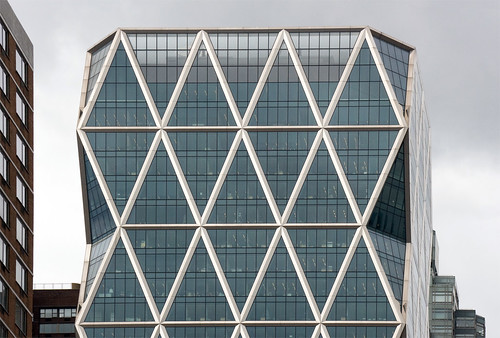
ENGLISH
Client: Hearst Corporation
Architect: Foster + Partners
Structural Engineer: WSP Cantor Seinuk
Category: High-rise
Height: 182 meters
Use: Offices
Floors: 46
Area: 79.524 sq. m.
The renowned architect Norman Foster had the great challenge of presenting the project of the Hearst Tower sad days after the attacks of 11 S. The important Hearst Corporation commissioned the famous architect a new landmark building that would house the offices of the various publications pertaining to the major publishing company in New York City. He demolished the old building built in the twenties from inside respecting the old facade of six floors and Art Deco. The materials used in the beautiful facade are some sections of stainless steel and highly resistant special glass to keep heat and penetrating radiation.
The start of the structure, huge pillars up both vertical and inclined for better upkeep of the building, in this way got a big welcome airy lobby to the building with an escalator and a source in three-story drop that achieved greatly cool the building, thus saving energy this entails. On the cover of this huge lobby glass panels were also opened for the best use of natural light inside, and through this important area connecting all building services. With the design of the facade by striking steel structure as a grid "diagrid" laden with diagonal beams, was also achieved savings up to 20% more steel than a conventional skyscraper.
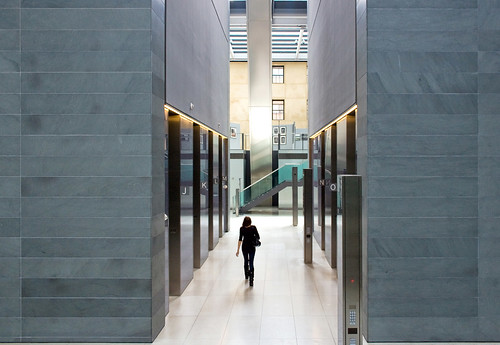
View of the central elevator access to floors of offices / Vista del núcleo centralizado de ascensores de acceso a las plantas de oficinas

85% of steel used in the new building is recycled, so that the Hearst Tower has become the first ecological skyscraper for the 21st century New York City. The Hearst Tower, which was inspired by the carved figure of a diamond with its characteristic diagonal beams in charge, has become without doubt one of the most beloved and representative buildings of American architecture, not in vain, the important high-rise belonging to the list of the 150 most important and representative buildings of America, a leading list has been prepared by the prestigious American Institute of Architects AIA.
All the images of the Hearst Tower here
Drawings Copyright © Foster + Partners
Images "Hearst Tower" and "Text"
Copyright © José Miguel Hernández Hernández
Editor, Escritor y Fotógrafo de Arquitectura /
Publisher, Writer and Architectural Photographer
Todos los derechos reservados / All rights reserved
www.jmhdezhdez.com
Related articles / Artículos relacionados
Floor 2 Hotel Puerta America
Madrid, Spain
30 St. Mary Axe
London, United Kingdom
Viaduct Millau
Aveyron, France
City Hall
London, United Kingdom
Millenium Bridge
London, United Kingdom
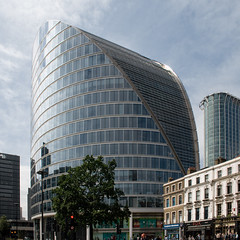
Moor House
London, United Kingdom
Canary Wharf Underground Station
London, United Kingdom
Other works in New York / Otras obras en Nueva York
Bank of America Tower
Manhattan, New York, USA
Cook+Fox Architects LLP
The IAC Building
New York City, USA
Gehry Partners LLP
The New York Times Building
Manhattan, New York City, USA
Renzo Piano Building Worldshop
Two World Trade Center
Manhattan, New York, USA
Minoru Yamasaki & Associates
Seagram Building
Manhattan, New York City, USA
Mies van der Rohe
MUY IMPORTANTE!!! VERY IMPORTANT!!!
Deja tu comentario sobre este reportaje al pie de este post donde dice "Publicar un comentario en la entrada"; me será de gran valor para seguir mejorando este sitio web y te contestaré con la mayor brevedad posible... Muchas gracias!
No obstante, si te ha resultado interesante este reportaje y también el Blog en general, por favor, no dudes en hacerte Fan de la página de Fans del Blog de José Miguel Hernández Hernández en Facebook aquí
Nota importante: Una vez que hayas entrado en la página de Fans del Blog en Facebook, con sólo hacer click en el botón de "Me gusta", a partir de ese momento estarás al tanto de todos los nuevos reportajes interesantes relacionados con la Arquitectura y la Ingeniería que aquí se vayan publicando para no perder ningún detalle...
También puedes suscribirte por e-mail (te llegaría un e-mail con el enlace de cada artículo en el mismo momento en que sea publicado), o bien también puedes seguir el Blog a través de Twitter aquí
Nos vemos en el Blog!
Leave a comment on this story at the bottom of this post where it says "Post a comment in the entry", I will prove invaluable to further improve this website and I will answer as soon as possible .. . Thank you very much!
However, if you this story was interesting and the blog in general, please do not hesitate to make Fan Fans of the Blog page José Miguel Hernández Hernández on Facebook here
Very important: Once you enter the page Blog fan of Facebook, simply click on the button Like "From that moment you are aware of all new interesting stories related to the Architecture and Engineering are published here to avoid losing any detail ...
Can also subscribe by e-mail (I would e-mail with a link to each item in the same time it is published), or you can follow through Blog Twitter here
See you at the Blog!
HOME GEOGRAPHY ARCHITECTURE ENGINEERING SKYSCRAPERS
BRIDGES BUILDINGS TOWERS PUBLICATIONS ABOUT ME CONTACT
Copyright © José Miguel Hernández Hernández
Editor, Escritor y Fotógrafo de Arquitectura /
Publisher, Writer and Architectural Photographer
http://www.jmhdezhdez.com/ Leer más...
Etiquetas:
Art Decó,
facade,
glass,
Hearst Corporation,
Hearst Tower,
High-Rise,
Manhattan,
Midtown,
New York,
Norman Foster + Partners,
Nueva York,
Torre Hearst,
United States,
USA
Taipei 101, Taiwan, 1997-2004
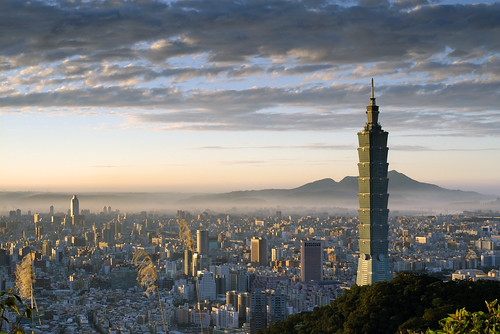
ESPAÑOL
Cliente: Taipei Financial Center Corporation
Arquitecto: C. Y. Lee & Partners
Structural Engineer: Evergreen Engineering
Categoría: Skyscraper (Super-Tall) + 300 meters
Altura: 509 metros
Plantas: 101
Uso: Mixto
Localizada en la ciudad de Taipei, capital de la isla de Taiwan al sur de China, la Taipei 101 con sus 509 metros de altura ostentaba el récord del mundo hasta la fecha siendo el rascacielos más alto, hasta que acaba de ser inaugurado en el inicio de este año 2010, el ya famoso Burj Dubai, con 828 metros de altura. Su diseño, que se llevó a cabo por la prestigiosa firma de arquitectos C. Y. Lee. & Partners, está inspirado en la arquitectura tradicional china y evoca la figura de una pagoda de 8 puntas, número de la suerte en este país. China se empeño en construir el rascacielos más alto del mundo y para ello tuvo que sobreponerse a varias dificultades añadidas como los habituales terremotos que azotaban esta zona geográfica durante gran parte del año. Los cálculos darían una cimentación con nada menos que 380 pilotes de 80 metros de profundidad cada uno. La superestructura del edificio está compuesta por 36 columnas interconectadas, ocho de ellas denominadas "Mega-columnas", debido a su dimensión, que se sitúan a modo de anillo en el perímetro del edificio. Estas 36 columnas son el soporte del rascacielos y tienen como misión transmitir las cargas a la cimentación del edificio.
La distribución de cada planta es sencilla, el espacio de oficinas se sitúa alrededor de un núcleo centralizado de servicios donde se alojan los ascensores y las escaleras de emergencia. El edificio cuenta con 48 ascensores que construyó la Empresa Toshiba para ofrecer el servicio más rápido y eficiente del mundo. En la planta 92, una enorme bola de acero de 680 toneladas de peso sujetada por fuertes cables y 8 gatos hidráulicos, le dan la estabilidad que necesita el edificio para soportar terremotos de hasta 7 puntos en la escala Richter y vientos de más de 450 Km./h. El Consejo de Edificios Altos y Hábitat Urbano(CTBUH), con sede en Chicago, otorgaría también a la Taipei 101 varios records; altura máxima estructural: 509 metros; altura del piso más alto ocupado: 438 metros; y altura de la azotea: 448 metros. El famoso Canal de Televisión Discovery Channel concedería el galardón a la Torre de Taipei como una de las Siete Maravillas de la Ingeniería en 2005. Además, en abril de 2006, la prestigiosa revista Newsweek Magazine, otorgaba también a la Torre más alta del mundo el premio como una de las Siete Maravillas del Mundo.
El texto de este artículo se incluye en mi libro titulado "CONSTRUCCIONES FAMOSAS" / The text of this item is included in my book title "FAMOUS CONSTRUCTIONS" Español - English
by José Miguel Hernández Hernández
Publisher, Writer and Architectural Photographer
www.jmhdezhdez.com
Video promotional
ENGLISH
Client: Taipei Financial Center Corporation
Architect: C. Y. Lee & Partners
Structural Engineer: Evergreen Engineering
Categorie: Skyscraper (Super-Tall) + 300 meters
Height: 509 meters
Floors: 101
Use: Mixed
Located in Taipei City, capital of the island of Taiwan to southern China, the Taipei 101 with its 509 meters height held the world record to date being the tallest skyscraper until just been inaugurated in the beginning This year 2010, the now famous Burj Dubai, with 828 meters high. Its design, which was conducted by the prestigious architectural firm of C. Y. Lee. & Partners, is inspired by traditional Chinese architecture and evokes the shape of a pagoda, 8 points, lucky number in this country. China is committed to build the tallest skyscraper in the world and it had to overcome several additional difficulties as the usual earthquake in this geographical area for much of the year. The calculations give a foundation for nothing less that 380 piles 80 meters deep each. The superstructure of the building is interconnected with 36 columns, eight of them called "mega-columns" because of its size, lying like a ring around the perimeter of the building. These 36 columns are the support of the skyscraper and are tasked to transmit the loads to the foundation of the building.
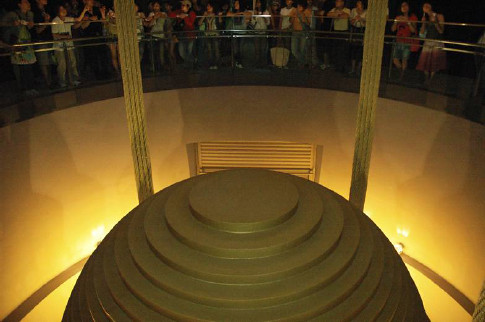
The distribution of each plant is simple, the office space is located around a central core that hosts services elevators and emergency staircases. The building has 48 elevators built by Toshiba Company to offer the fastest and most efficient service in the world. On the ground 92, a huge steel ball weighing 680 tonnes held by strong cables and 8 hydraulic jacks give you the stability you need the building to withstand earthquakes of up to 7 points on the Richter scale and winds of over 450 km . / h. The Council on Tall Buildings and Urban Habitat (CTBUH), headquartered in Chicago, also give it to several records Taipei 101, Maximum structural height: 509 meters, height of highest occupied floor: 438 feet, and height of the roof: 448 meters. The famous Discovery Channel Television Station granted the award to the Tower of Taipei as one of the Seven Wonders of Engineering in 2005. Furthermore, in April 2006, the prestigious magazine Newsweek Magazine, also for the world's tallest tower the award as one of the Seven Wonders of the World.
Images "Taipei 101"
© Copyright Daniel M. Shih, Photostream
"Text" and "Video" © José Miguel Hernández Hernández
Editor, Escritor y Fotógrafo de Arquitectura /
Publisher, Writer and Architectural Photographer
Todos los derechos reservados / All rights reserved
www.jmhdezhdez.com
Related articles / Artículos relacionados
Petronas Twin Towers
Kuala Lumpur, Malaysia
Cesar Pelli & Associates
Willis Tower
Chicago, Illinois, USA
Skidmore, Owings & Merrill LLP, SOM
Empire State Building
Manhattan, New York
Shreve, Lamb & Harmon Associates
MUY IMPORTANTE!!! VERY IMPORTANT!!!
Deja tu comentario sobre este reportaje al pie de este post donde dice "Publicar un comentario en la entrada"; me será de gran valor para seguir mejorando este sitio web y te contestaré con la mayor brevedad posible... Muchas gracias!
No obstante, si te ha resultado interesante este reportaje y también el Blog en general, por favor, no dudes en hacerte Fan de la página de Fans del Blog de José Miguel Hernández Hernández en Facebook aquí
Nota importante: Una vez que hayas entrado en la página de Fans del Blog en Facebook, con sólo hacer click en el botón de "Me gusta", a partir de ese momento estarás al tanto de todos los nuevos reportajes interesantes relacionados con la Arquitectura y la Ingeniería que aquí se vayan publicando para no perder ningún detalle...
También puedes suscribirte por e-mail (te llegaría un e-mail con el enlace de cada artículo en el mismo momento en que sea publicado), o bien también puedes seguir el Blog a través de Twitter aquí
Nos vemos en el Blog!
Leave a comment on this story at the bottom of this post where it says "Post a comment in the entry", I will prove invaluable to further improve this website and I will answer as soon as possible .. . Thank you very much!
However, if you this story was interesting and the blog in general, please do not hesitate to make Fan Fans of the Blog page José Miguel Hernández Hernández on Facebook here
Very important: Once you enter the page Blog fan of Facebook, simply click on the button Like "From that moment you are aware of all new interesting stories related to the Architecture and Engineering are published here to avoid losing any detail ...
Can also subscribe by e-mail (I would e-mail with a link to each item in the same time it is published), or you can follow through Blog Twitter here
See you at the Blog!
HOME GEOGRAPHY ARCHITECTURE ENGINEERING SKYSCRAPERS
BRIDGES BUILDINGS TOWERS PUBLICATIONS ABOUT ME CONTACT
Copyright © José Miguel Hernández Hernández
Editor, Escritor y Fotógrafo de Arquitectura /
Publisher, Writer and Architectural Photographer
http://www.jmhdezhdez.com/ Leer más...
Puente de la Barqueta, Sevilla, Andalucía, España, 1988
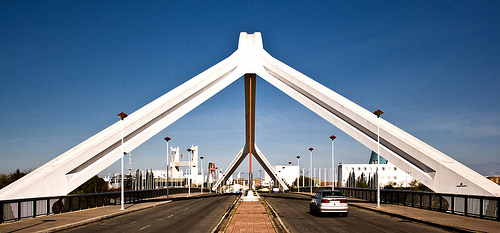
ESPAÑOL
Cliente: EXPO 92 de Sevilla
Ingeniero: Juan José Arenas de Pablo & Asociados
Tipo de puente: De arco atirantado
Vano: 168 metros
Uso: Mixto
La EXPO 92 de Sevilla encargaba al prestigioso Ingeniero Juan José Arenas de Pablo el diseño de un puente para unir la ciudad histórica de Sevilla con la isla de la Cartuja donde se iba a celebrar la importante Exposición Universal de Sevilla en el año 1992. Se diseñó un puente realmente innovador mediante una estructura mixta de acero y hormigón armado que se ha convertido en todo un símbolo para esta ciudad del sur de España. Dos pórticos inclinados de forma triangular en ambos extremos del puente, se combinaron con un gran arco central de acero. Esta enorme estructura de acero descansa sobre una cimentación vista de hormigón armado mediante cuatro pilares situados en los cuatro vértices y a 30 metros de distancia en el sentido transversal del mismo. Estos dos pórticos triangulares e inclinados de acero que reciben la fuerza axial del arco para que no se desplome este y que trasmiten las cargas a la cimentación, sirvieron también para hacer de puerta de entrada para el importante evento.
En el eje central de la pasarela y el sentido longitudinal del puente se dispusieron los cables atirantados que hacen la labor de sustentar el tablero de 168 metros de longitud total. El sistema constructivo del puente fue bastante sencillo. Después de construir la estructura en tierra en uno de los dos lados, se giraría posteriormente sobre unas balsas de gran resistencia a través del cauce para hacerla coincidir milimétricamente con los cuatro apoyos de hormigón armado situados en los cuatro vértices a ambos lados del río. Un uso mixto se le dió a este puente de arco atirantado que se ha convertido en todo un icono para la ciudad de Sevilla y que cuenta con dos carriles de tráfico rodado en ambos sentidos y otras dos pasarelas peatonales en los extremos. Junto con el Puente del Alamillo, obra del prestigioso arquitecto-ingeniero español Santiago Calatrava, el Puente de la Barqueta ha conseguido embellecer y revitalizar este bello paraje natural andaluz.

ENGLISH
Client: EXPO 92 of Seville
Engineer: Juan José Arenas de Pablo & Associates
Type of bridge: Arch cable-stayed
Avail: 168 meters
Use: Mixed
EXPO 92 in Seville instructed the prestigious Mr. Juan José Arenas de Pablo the design of a bridge linking the historical city of Seville with the Cartuja island where it was to celebrate the important Exhibition in Seville in 1992. We designed a truly innovative bridge through a mixed structure of steel and reinforced concrete has become a symbol for this city in southern Spain. Two triangular shaped sloping porches at both ends of the bridge, combined with a large central arch of steel. This enormous steel structure rests on a view reinforced concrete foundation with four pillars located at the four corners and 30 feet away in the transverse direction thereof. These two porches and sloping triangular steel receiving the axial force of the bow so it does not crash this and loads transmitted to the foundation, also served to make the gateway to the important event.

At the core of the gateway and the longitudinal direction of the bridge stay cables were arranged to make the work of sustaining the board of 168 meters in length. The bridge construction system was fairly simple. After building the structure on land in one of the two sides, turn around later on heavy-duty rafts through the channel to make it match the four millimeter concrete supports located at the four corners on both sides of river. A mixed use gave the tied arch bridge that has become an icon for the city of Seville and has two lanes of traffic in both directions and two pedestrian walkways at the ends. Along with the Alamillo Bridge, designed by renowned Spanish architect-engineer Santiago Calatrava, the bridge has got Barqueta beautify and revitalize this beautiful natural landscape of Andalusia.
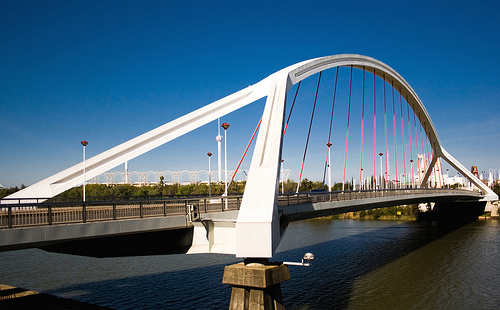
All the images Barqueta Bridge here
Images "Barqueta Bridge" and "Text"
Copyright © José Miguel Hernández Hernández
Editor, Escritor y Fotógrafo de Arquitectura /
Publisher, Writer and Architectural Photographer
Todos los derechos reservados / All rights reserved
www.jmhdezhdez.com
Related articles / Artículos relacionados
Reggio Emilia Bridges
Mancasale, Bolonia, Italia
Santiago Calatrava
Pasarela Campo Volantín
Bilbao, Spain
Santiago Calatrava

Bach de Roda Bridge
Barcelona, Spain
Santiago Calatrava
Puente del Alamillo
Sevilla, Andalucía, Spain
Santiago Calatrava
MUY IMPORTANTE!!! VERY IMPORTANT!!!
Deja tu comentario sobre este reportaje al pie de este post donde dice "Publicar un comentario en la entrada"; me será de gran valor para seguir mejorando este sitio web y te contestaré con la mayor brevedad posible... Muchas gracias!
No obstante, si te ha resultado interesante este reportaje y también el Blog en general, por favor, no dudes en hacerte Fan de la página de Fans del Blog de José Miguel Hernández Hernández en Facebook aquí
Nota importante: Una vez que hayas entrado en la página de Fans del Blog en Facebook, con sólo hacer click en el botón de "Me gusta", a partir de ese momento estarás al tanto de todos los nuevos reportajes interesantes relacionados con la Arquitectura y la Ingeniería que aquí se vayan publicando para no perder ningún detalle...
También puedes suscribirte por e-mail (te llegaría un e-mail con el enlace de cada artículo en el mismo momento en que sea publicado), o bien también puedes seguir el Blog a través de Twitter aquí
Nos vemos en el Blog!
Leave a comment on this story at the bottom of this post where it says "Post a comment in the entry", I will prove invaluable to further improve this website and I will answer as soon as possible .. . Thank you very much!
However, if you this story was interesting and the blog in general, please do not hesitate to make Fan Fans of the Blog page José Miguel Hernández Hernández on Facebook here
Very important: Once you enter the page Blog fan of Facebook, simply click on the button Like "From that moment you are aware of all new interesting stories related to the Architecture and Engineering are published here to avoid losing any detail ...
Can also subscribe by e-mail (I would e-mail with a link to each item in the same time it is published), or you can follow through Blog Twitter here
See you at the Blog!
HOME ARCHITECTS GEOGRAPHY SKYSCRAPERS BRIDGES BUILDINGS TOWERS COPYRIGHT PUBLICATIONS ABOUT ME CONTACT
Copyright © José Miguel Hernández Hernández
Editor, Escritor y Fotógrafo de Arquitectura /
Publisher, Writer and Architectural Photographer
http://www.jmhdezhdez.com/ Leer más...
Bodegas Ysios, Laguardia, Álava, España, 1998-2000

ESPAÑOL
Cliente: Bodegas Ysios
Arquitecto: Santiago Calatrava
Superficie: 8000 m²
Con un ancho de 26 metros y de planta rectangular salvo la majestuosa entrada principal que la interrumpe, las Bodegas Ysios disponen de casi 200 metros de longitud total y se alza espléndida en un lugar auténticamente privilegiado al pie de las montañas de la Sierra de Cantabria. Localizado concretamente en la zona de Laguardia, Rioja Alavesa, el singular edificio destaca desde lo lejos por su preciosa cubierta a modo de ondas marinas. Como es habitual en él, Calatrava marca en gran medida el acceso principal por el que se accede a cada una de sus obras. La madera natural contrasta en gran medida con el revestimiento del aluminio que cubre la totalidad de la cubierta a base de vigas con sección rectangular que inclinadas, van dibujando formas cóncavas y convexas y donde nada es recto.
La sorprendente estructura se compone básicamente de dos muros de carga en el sentido longitudinal de la nave, que siendo también curvos al igual que la cubierta, Calatrava los revistió en su interior con unas lamas de madera tratada. Ya en el exterior, el arquitecto nos sorprendió aplicando el aluminio natural de color plata y de preciosas coloraciones. Destaca en gran medida la entrada principal del singular edificio que se eleva por encima del resto del majestuoso conjunto. Finalmente Santiago Calatrava rodeó la fachada principal de las Bodegas con una lámina de agua, complemento esencial del famoso arquitecto en la mayor parte de sus obras.
El texto de este artículo se incluye en mi libro titulado "CALATRAVA - SU OBRA EN ESPAÑA" / The text of this item is included in my book title "CALATRAVA - HIS WORK IN SPAIN" Español - English
by José Miguel Hernández Hernández
Publisher, Writer and Architectural Photographer
www.jmhdezhdez.com
ENGLISH
Client: Winery Ysios
Architect: Santiago Calatrava
Area: 8000 m²
With a width of 26 meters and rectangular except the stately main entrance interrupts the Ysios Wineries have almost 200 meters in length and rises in a truly splendid privileged at the foot of the mountains of the Sierra de Cantabria. Located precisely in the area of Laguardia, Rioja Alavesa, the unique building stands out from afar for its beautiful cover by way of sea waves. As is usual with him, largely Calatrava mark the main entrance which is accessed by each of their works. Natural wood contrasts sharply with the aluminum coating that covers the entire deck base rectangular section beams bent, van drawing concave and convex forms, and where nothing is straight.
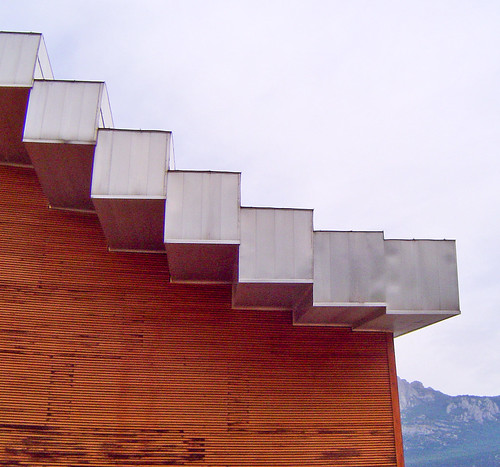
The surprising structure consists basically of two load-bearing walls in the longitudinal direction of the ship, which being also curved like the cover, Calatrava's clothed inside with a treated wood slats. Already on the outside, we were surprised by the architect using the natural aluminum color silver and precious colors. Stresses largely unique main entrance building that rises above the rest of the majestic whole. Santiago Calatrava finally surrounded the main facade of the wineries with a sheet of water, essential complement to the famous architect in the majority of his works.
All the images of Winery Ysios
Images "Winery Ysios" "Text" and "Video"
Copyright © José Miguel Hernández Hernández
Editor, Escritor y Fotógrafo de Arquitectura /
Publisher, Writer and Architectural Photographer
Todos los derechos reservados / All rights reserved
www.jmhdezhdez.com
References / Referencias
Santiago Calatrava-Turning Torso
Bellisco Ediciones, Madrid, 2008
by José Miguel Hernández Hernández
Español - English
+info
Related articles / Artículos relacionados
HSB Turning Torso
Malmo, Sweden
Aeropuerto de Sondica
Bilbao, Spain
Bou
Mallorca, Islas Baleares, Spain
Auditorio de Tenerife
Santa Cruz de Tenerife,
Islas Canarias, Spain
CAC Valencia
Ciudad de las Artes y
las Ciencias, Valencia, Spain
MUY IMPORTANTE!!! VERY IMPORTANT!!!
Deja tu comentario sobre este reportaje al pie de este post donde dice "Publicar un comentario en la entrada"; me será de gran valor para seguir mejorando este sitio web y te contestaré con la mayor brevedad posible... Muchas gracias!
No obstante, si te ha resultado interesante este reportaje y también el Blog en general, por favor, no dudes en hacerte Fan de la página de Fans del Blog de José Miguel Hernández Hernández en Facebook aquí
Nota importante: Una vez que hayas entrado en la página de Fans del Blog en Facebook, con sólo hacer click en el botón de "Me gusta", a partir de ese momento estarás al tanto de todos los nuevos reportajes interesantes relacionados con la Arquitectura y la Ingeniería que aquí se vayan publicando para no perder ningún detalle...
También puedes suscribirte por e-mail (te llegaría un e-mail con el enlace de cada artículo en el mismo momento en que sea publicado), o bien también puedes seguir el Blog a través de Twitter aquí
Nos vemos en el Blog!
Leave a comment on this story at the bottom of this post where it says "Post a comment in the entry", I will prove invaluable to further improve this website and I will answer as soon as possible .. . Thank you very much!
However, if you this story was interesting and the blog in general, please do not hesitate to make Fan Fans of the Blog page José Miguel Hernández Hernández on Facebook here
Very important: Once you enter the page Blog fan of Facebook, simply click on the button Like "From that moment you are aware of all new interesting stories related to the Architecture and Engineering are published here to avoid losing any detail ...
Can also subscribe by e-mail (I would e-mail with a link to each item in the same time it is published), or you can follow through Blog Twitter here
See you at the Blog!
HOME GEOGRAPHY ARCHITECTURE ENGINEERING SKYSCRAPERS
BRIDGES BUILDINGS TOWERS PUBLICATIONS ABOUT ME CONTACT
Copyright © José Miguel Hernández Hernández
Editor, Escritor y Fotógrafo de Arquitectura /
Publisher, Writer and Architectural Photographer
http://www.jmhdezhdez.com/ Leer más...
Suscribirse a:
Entradas (Atom)
